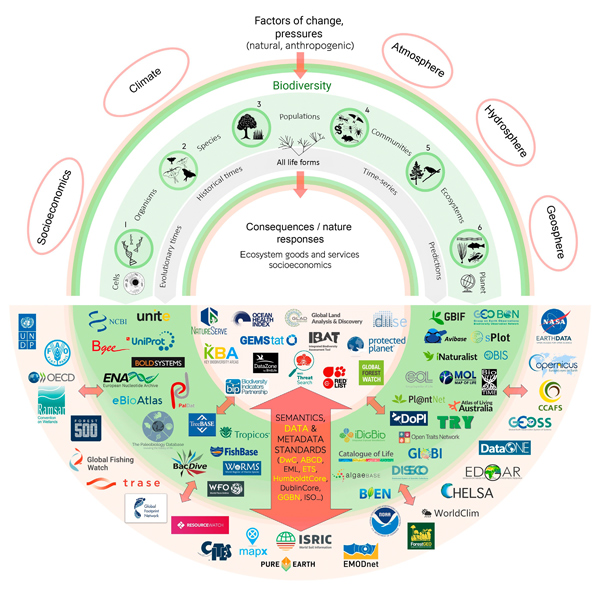August 2025: publication Trends in Ecology & Evolution
Defining biodiversity data
It is crucial to document biodiver-sity data and to take actions to halt the ongoing massive loss of biodi-versity. Yet, these data are poorly defined. We propose a definition of biodiversity data and discuss its im-plications for data management, enabling enhanced data mobiliza-tion for integrated research and effi-cient conservation strategies.

Fig. 1 – Upper part. The different facets of biodiversity are represented within the green ring along gradients of biological and ecological organizations (from cell components to species, population to ecosystem, and local to planet) and a temporal continuum (from evolutionary times to predictions) for all life forms. A wide range of biodiversity data, from a variety of sources, can be used to fill in the essential biodiversity variables (EBVs) in all their classes (green circles: 1 genetic composition; 2 species populations; 3 species traits; 4 community composition; 5 ecosystem functioning; 6 ecosystem structure), which represent some but not all, facets of biodiversity. Data describing the factors or pressures acting on biodiversity, or the consequences of human actions on nature, sometimes spill over (red arrows, see text) within the concept of ‘biodiversity data’ and make their definition ambiguous. Lower part. Mirroring the three data categories represented in the upper part, a non-exhaustive selection of representative databases, information systems or networks, is represented through their logos, illustrating the broad and complex landscape of relevance for biodiversity data and the considerable challenge at hand for data access, exchange, and persistence. Terminological resources and data (yellow text) or metadata (black text) standards, represented in the large central red double-arrow (and repeated locally by the small red double-arrows), are key to address this challenge.
References
Garnier E., Pelletier D., Roche P., Rougerie R., contributing members of the SC PNDB (including Olga Otero), Pavoine S. 2025 – Defining biodiversity data – Trends in Ecology & Evolution, 40, 8 – https://doi.org/10.1016/j.tree.2025.06.004




